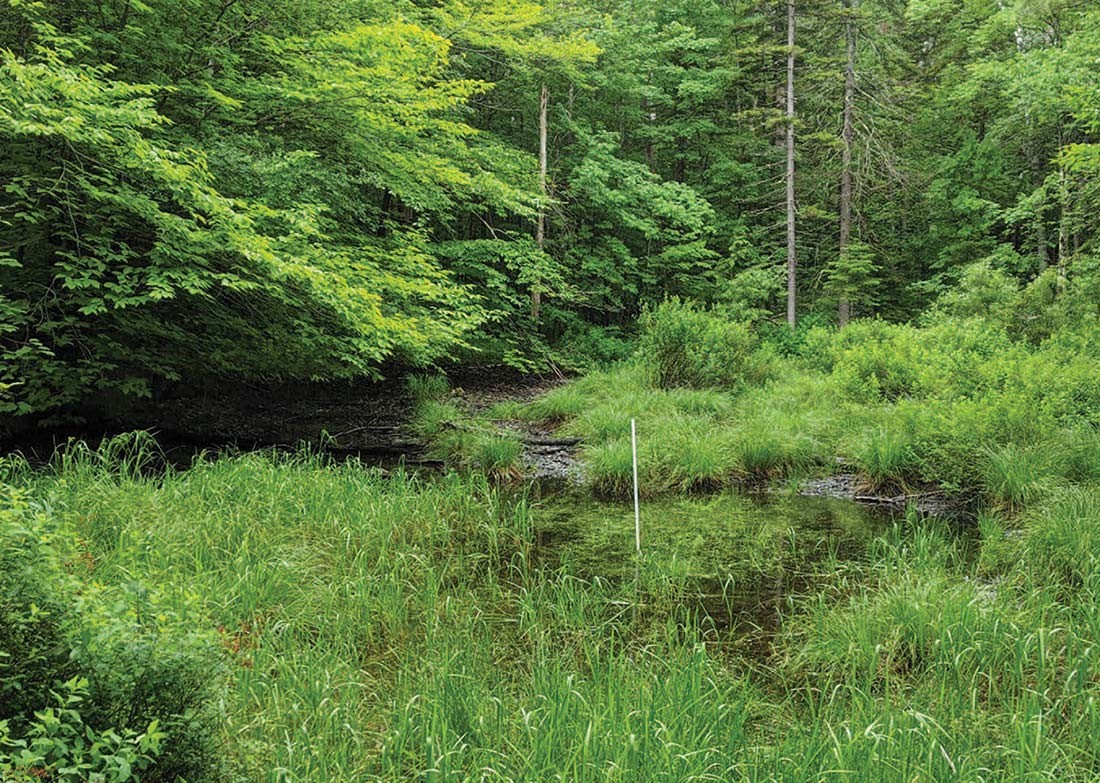
They may look like large puddles, but vernal pools teem with life. Among the most dynamic wetlands to explore in the spring woods, they provide critical breeding habitat for wood frogs, several species of salamander, and fairy shrimp, as well as support other wetland-dependent wildlife. Wood ducks often haunt them. Foxes and other predators patrol their edges. These fishless pools frequently dry up in late summer or fall, only to fill up again over the course of the winter, following an annual cycle of renewal.
Vernal pools have received growing attention from researchers and educators because of the significant role they play in forest health and in the resilience of wildlife populations that inhabit our woodlands. We know the basics – which species are key indicators of a vernal pool, when they tend to migrate to pools to reproduce, when they tend to leave, and a general sense of when the pools disappear later in the year. Scientists are still studying the details of how these ephemeral wetlands contribute to forest health and the intricate connections between breeding behavior and biophysical characteristics of individual pools.
“Citizen scientists” – people from all walks of life and interests – are working together with researchers and educators to help unravel some of these mysteries. In Vermont, the Vernal Pool Monitoring project created and led by Vermont Center for Ecostudies (VCE) is a model of scientific inquiry that relies on volunteer investigations of vernal pools and the ecological role they play. These volunteers follow systematic data gathering protocols so that the information they produce can be used to advance scientific reporting.
“Data from these pools is compared across regions or other variables, such as elevation, which adds to a broader knowledge of vernal pools throughout the state and how they contribute to healthy, resilient forests and the wildlife that rely on them,” said Kevin Tolan, VCE’s vernal pool monitoring coordinator.
Because forests and waterways are interconnected, what happens within these natural systems can, ultimately, have implications for our community well-being and regulatory infrastructure. For example, the presence of vernal pools in woodlands plays a role in how nutrients cycle through the forest and can contribute to better water quality. Also, as climate change indicators, vernal pools can help signal an area’s resilience (or lack of it) to changing temperatures and weather patterns.
VCE takes a comprehensive approach to monitoring, looking at breeding behavior and success of indicator species – wood frogs, blue spotted, Jefferson, and spotted salamanders, and fairy shrimp – and other invertebrates such as caddisflies. The program also investigates each pool’s hydroperiod – the length of time the pool holds water in a given year. This year marks VCE’s third season of data collection. The number of pools monitored has grown from 5 to 55, and volunteers now number well over 100.
Volunteers visit their designated pool three to four times a year. Early in the season, they set up HOBO data loggers – small sensors that record temperature, and audio recorders to capture the sound of frogs calling. During the second visit, they collect data on the number of wood frog and Jefferson or blue spotted salamander egg masses within a meter of the shore. In late spring, they identify and count spotted salamander egg masses, tadpoles, and larval salamanders. During their final visit in the fall, they document the presence of any lingering vernal pool species and download the data from the HOBO logger.
Over time, patterns will emerge in the data, and scientists will be able to detect changing vernal pool conditions and alterations in the behavior of vernal pool species. This information will help reveal overall forest response to climate change and may influence land management decisions.



VCE Project Goals & Objectives
- Build a base of knowledge regarding the state of vernal pools in Vermont
- Raise awareness about the value of vernal pools by involving the public in monitoring
- Advance vernal pool conservation planning at the state and local levels
Regional Resources
- Learn more about vernal pool conservation and VCE’s projects.
- Vermont Vernal Pool Monitoring VPMon 2019 Manual
- Vermont residents can contribute information on vernal pools.
- New York Natural Heritage Program Vernal Pool Guide
- New Hampshire Vernal Pool Documentation Manual
- For information on vernal pool education and protection throughout the Northeast.


